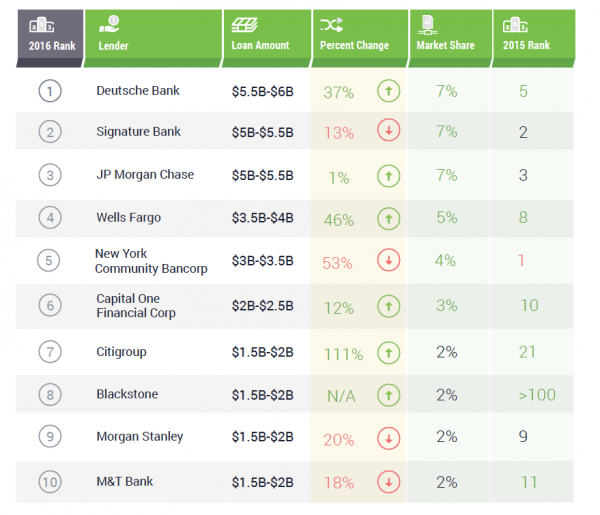Trending
NYC real estate lending fell in 2016 amid multifamily worries
Deutsche was the most active lender, replacing NYCB: report

Lenders pumped less money into the New York City real estate market in 2016 amid a slowdown in property sales and fears over the health of the multifamily sector.
Commercial real estate lending volume fell to $82 billion in 2016, down 17 percent from $99 billion year-over-year, according to a new report from lending database CrediFi.
“Overall liquidity in the market is down substantially,” said CrediFi CEO Ely Razin. “If you can still get the loan, it may take you longer — that’s a pretty substantial change.”
CrediFi’s data does not include most construction loans, though banks have been tightening the purse strings in the development market as well.
Deutsche Bank took over the top spot in CrediFi’s lender ranking, growing its origination volume by 46 percent to $6 billion despite a difficult year that included a $7.2 billion settlement with the U.S. Justice Department over pre-crisis mortgages. Wells Fargo and Citigroup also grew their lending volume.
One reason for the drop in overall lending volume, according to Razin, is that 2015 was an exceptionally busy year with plenty of big-ticket deals in need of financing. In comparison, 2016 was bound to look worse. But the drop also reflects a new sense of caution among multifamily lenders.
In December 2015, federal banking regulators issued a joint statement warning banks that overexposure to multifamily loans could threaten financial stability. Banks seem to have taken the warning to heart. Lending on New York City apartment buildings fell by 23 percent to $29 billion in 2016, and the city’s two biggest multifamily lenders, New York Community Bank and Signature Bank, slashed their deal volume. NYCB was the city’s top lender in 2015 with $5.3 billion in loans, but in 2016, it fell to fifth place as its loan origination volume shrank by a staggering 53 percent to $2.6 billion (a NYCB spokesperson told TRD the bank’s own numbers show a 49-percent decline).
“One possible explanation for New York Community Bank’s larger drop in lending is that the bank appears to be making an effort to keep its total assets below $50 billion, in a bid to avoid being classified as a systemically important financial institution under the Dodd-Frank Act,” CrediFi’s report notes. “A SIFI designation would subject the bank to stricter standards and regulations.”
Signature Bank’s multifamily lending volume fell by 13 percent to $3.7 billion.
A recent apartment construction boom in Manhattan and parts of Brooklyn and Queens has stoked fears of oversupply. Rents are already falling, concessions are rising, and earlier this month multifamily billionaire Richard LeFrak argued that rents will have to fall by 15 percent for the market to reach equilibrium.
There are some important caveats to the ranking. CrediFi only lists one lender for some loans that are in fact syndicated, which can skew numbers. And in the case of a $1.2 billion loan to GID Development Group’s Waterline Square project on the Upper West Side, CrediFi lists the New York State Housing Finance Agency as the lender, even though HFA merely issued bonds that were ultimately bought by Wells Fargo and other lenders.
Another notable trend in 2016 was the rise in non-bank lending. Blackstone Group cracked the top 10 for the first time, issuing more than $1.5 billion in loans over the course of the year. The fund manager backed Kushner Companies and CIM Group’s acquisition of the Watchtower building in Dumbo with a $376 million loan in partnership with SL Green Realty. Aareal Capital, Acore Capital and Starwood Capital Group, which manage debt funds, also ramped up their lending activity in 2016.




